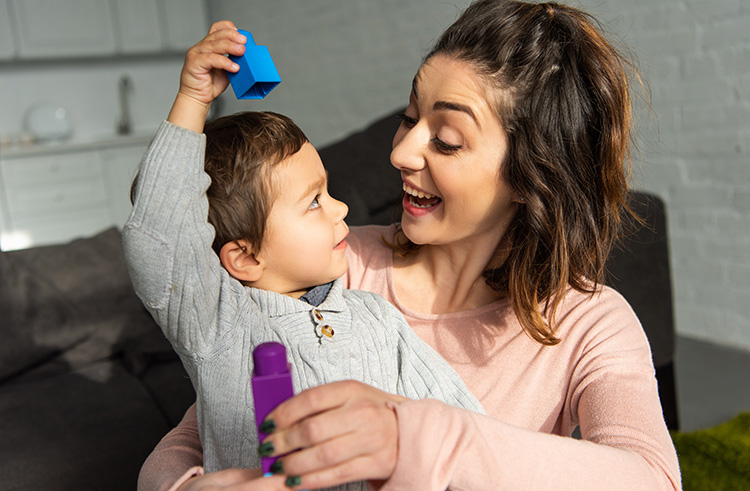Speak to your child in his language
*For purposes of this blog, gender of child was randomly chosen as “he/him/his”
We’ve all heard of them – the infamous toddlers who spoke in full sentences at 18 months. Their parents proudly state: “We always spoke to him in full sentences and we never used baby talk.” In actual fact, their child spoke early despite that, not because of it. This blog is not meant for parents of overly precocious toddlers who are exceeding speech and language milestones. This blog is written for parents of toddlers who are struggling to acquire language. What can you, the parent, do to help? One of the first things you can do to help your toddler, is communicate to him in his language.

Communicating with your child at the right level
Any adult who has tried to learn a new language knows that it is significantly easier to understand when the speaker uses short, simple sentences, spoken slowly. The same principles apply to your child who is learning language. When we speak in full sentences to our toddler who is not yet speaking, he hears gibberish. A great rule of thumb for communicating with toddlers is: LESS IS MORE!
We want to communicate with children at their level and just ONE step above where they are at.
Level 1: Your Child Has No Words – ‘Yet’
If your child has no words yet, then you want to communicate with him just one step above where he is at: a one-word level. Many parents find this challenging – speaking one word at a time feels strange. It’s also very annoying to older children and other adults 😉 But this is the best way to get your child to “hear” you and be your communication partner! As adults, we do not enjoy interacting with someone who doesn’t speak to us in our language and your child is no different! If you want your child to communicate with you, first start by speaking to him in his language. As soon as you shift to speaking in single words, you will notice how much more he will attend to you. Once he starts to focus more, the words you keep saying and repeating will be processed and retained. Once he retains all these words that you are teaching him, he makes the leap of trying them out for himself. Voila! Your child is speaking words!
Level 2: Your Child is Starting to Use Single Words
Once your child is using single words, you will communicate with him at a one-word and two-word level; his level plus one level above where he is.
A common question that parents ask is: “Shouldn’t my sentences be grammatically correct?” In other words, parents are concerned that short two-word phrases that they model to their child are not grammatically accurate. There are two schools of thought within our field with regards to this question. Some SLPs hold the position that a caregiver’s model should always be accurate even if that means speaking to your child beyond their level. The fear is that providing an incorrect model is worse than speaking above the child’s linguistic level. Other SLPs argue that providing the model of the correct level is more important. At Speech Pathways, our SLPs use more of a hybrid approach. We adhere to the rule of staying within the child’s correct level – by communicating one step above. However, we also advise parents to provide a more grammatically correct model as well (if possible).
Here’s an example of that hybrid approach: during a dressing routine, a mom communicating at Level 2 (two-word level), models “Sock on, sock on”. Then she also adds “putting socks on”. If we are guided by typical language development, a toddler naturally progresses from single word use to two-word use. Children who struggle with developing language need to be taught how to do that. We are not concerned when a typically developing toddler produces a grammatically incorrect phrase. For example, it is perfectly normal for a 2 year old to say “Me no want”. That toddler has just successfully communicated a protest. Over his second and third year his pronouns will be shaped from “me” to “I” and negation of “no” to “don’t” will develop. If we accept this for typically developing language skills, we cannot impose even higher expectations for children with language delays.
Level 3: Combining words together
Once your child is combining two or more words together, that is when you can start modelling short sentences. Communicating simple and short sentences will ensure that you are still within one level of your child’s communication ability. The following two types of simple sentences are perfect for modelling at this stage:
- Subject-verb-object
- Subject-is-verbing
Examples of subject-verb-object sentences
- Mommy cuts berry
- Joey kicks ball
- Daddy kiss baby
- Joey eats banana
You can model these types of sentences in any routine that you are doing with your toddler. Label every action that you are doing with your toddler in a simple way that he will be more likely to attempt to say these sentences himself. Here are some examples of using simple subject-verb-object sentences in everyday routines:
Dressing routine
- Joey wears socks
- Joey wears pants
- Joey wears shirt
- Joey wears shoes
Bath time routine
- Joey washes foot
- Joey washes hand
- Joey washes leg
- Joey washes ears

Examples of subject-is-verbing sentences
- Mommy is cooking
- Joey is drinking
- Daddy is driving
- Doggy is sleeping
These sentences are perfect to model while labeling everyday routines as well.
Play time
- Cow is eating
- Duck is swimming
- Car is driving
- Ball is bouncing
Meal prep
- Mommy is washing
- Mommy is cutting
- Daddy is stirring
- Daddy is cooking
These two types of sentences: subject-verb-object and subject-is-verbing are just suggestions to help you keep it simple. Any type of simple sentence will do. Naturally there will be times when you communicate with your child using longer sentences.

There are many reasons why a toddler may have delays in acquiring language. However, communicating to a child at their linguistic level is helpful for all children – regardless of the reason for their delay. We hope you reap the rewards that simplifying your speech will bring by watching your child’s vocabulary start to grow!
